Easy Overnight Sourdough Bread Recipe
This easy overnight sourdough bread recipe is meant to fit any schedule. Perfect for working moms or sourdough beginners!
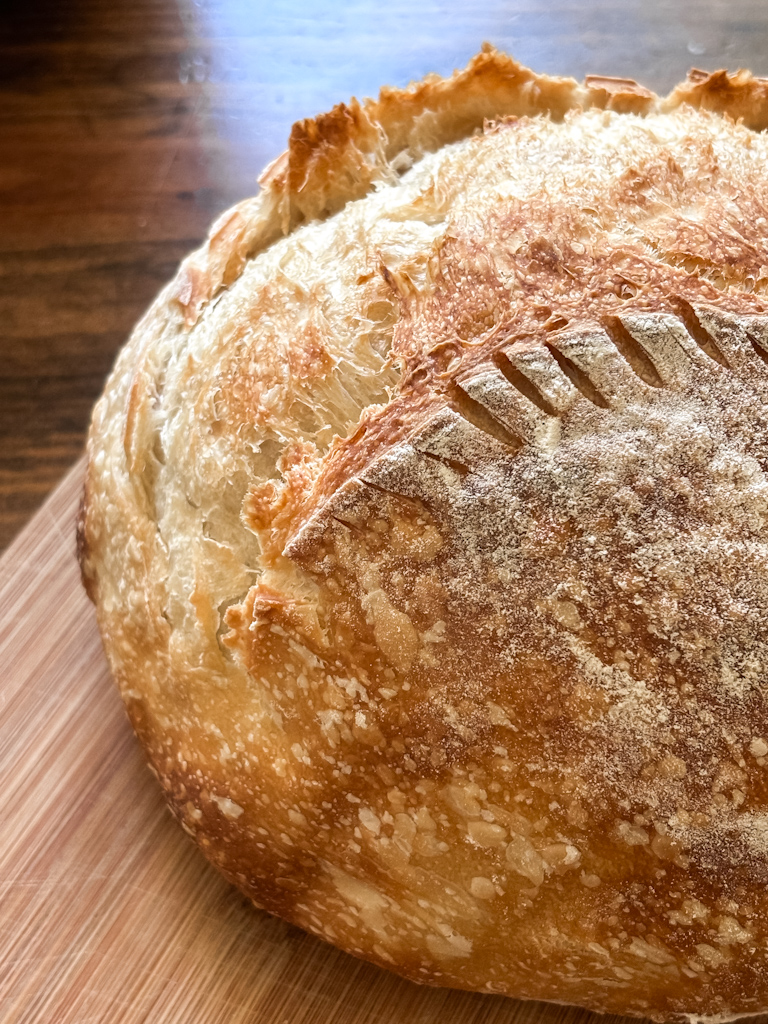
What Is Overnight Sourdough Bread?
Overnight sourdough bread is a type of sourdough bread that undergoes an extended fermentation period, typically overnight or for around 12-16 hours, at a cooler temperature. This slow fermentation process allows the flavors to develop and enhances the texture of the bread.
By fermenting the dough overnight, the natural yeast and bacteria in the sourdough starter have more time to work. Additionally, the longer fermentation helps improve the digestibility of the bread and may also contribute to a better rise and crumb structure.
Overall, overnight sourdough breads tend to have a deeper flavor, a chewier texture, and a more pronounced sourdough taste compared to breads made with shorter fermentation times. In short, it’s delish.
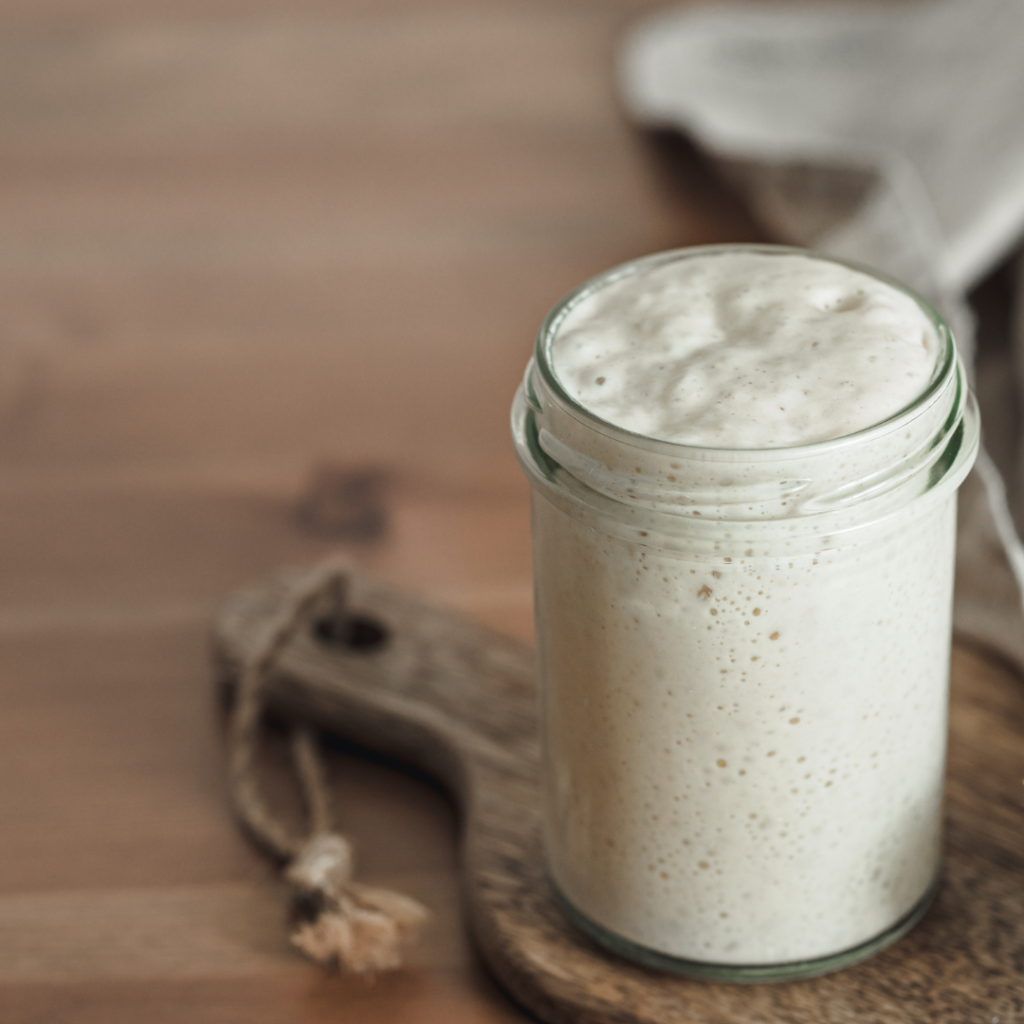
How Do I Make A Sourdough Starter?
Making a sourdough starter is a simple process! The truth is, it’s as easy as mixing flour and water but it will take patience. I’ve helped thousands of people make their own starter by providing a FREE step-by-step guide and you can get yours HERE!

New to sourdough?
Check out my work at your own pace video course: Sourdough Basics
Unlock the world of sourdough with the Sourdough Basics Mini-Course! Tailored for beginners, this course simplifies the sourdough journey, demystifying the process and saving you valuable time. Say goodbye to overwhelming research and confusion. With easy-to-follow techniques and clear instructions, we transform sourdough into an understandable and joyful experience for everyone. Join us in mastering the basics and unleashing the joy of homemade sourdough!
How To Make Overnight Sourdough Bread
Make The Leaven
- 1 cup all-purpose flour
- 1 cup water
- 2 tablespoons starter
For this recipe, you will need an active starter. So before you make your sourdough bread, you’ll want to feed your starter. For this recipe, I suggest feeding your starter in the morning when you wake so that it has time to rise and double throughout the day.
Mix equal parts flour and water into your jar with about 2 tablespoons of starter. Cover and leave out to rise for 8-10 hours. This is perfect for those who work outside of the home. Simply feed your starter before leaving for work and you’ll come home to active, bubbly leaven that’s ready to be mixed into dough!
Mix The Dough
- 1 ½ cups leaven (fed starter that has doubled and bubbled)
- 2 ¾ cups water
- 8 cups all-purpose flour
- 1 tbsp salt

After your starter has doubled, it’s time to mix the dough. Add your bubbly starter and water into a large mixing bowl. Stir to disperse. Now add flour and stir until you’ve formed a shaggy dough. Cover and allow your dough to sit for about 20 minutes.
After 20 minutes, add salt and knead with your hands for 2-3 minutes. You may want to wet your hands so that the dough doesn’t stick and the salt will incorporate better. Cover and set to the side in a warm place.
Stretch and Fold
Now it’s time for a series of stretch and folds. To do this, gently grab the dough from the bottom stretching upwards, and fold down towards the center of the dough. Turn the bowl and repeat 3-4 times. This is best done with wet hands.
You’ll do 6 sets of stretch and folds in total. The first 3 sets are 15 minutes apart, and the last 3 you’ll do every 30 minutes.
Keep in mind this does not have to be exact! Sourdough is forgiving. I do like to set a timer so that I can go on about my business and just come back to stretch and fold as the timer goes off.
Be sure to cover your bowl in between stretch and folds.
Bulk Ferment
Once you’ve completed the period of stretch and folds, it’s time for your bulk fermentation. Bulk fermentation is a crucial stage in the sourdough bread-making process where the entire dough is allowed to ferment before shaping.
During this time, the naturally occurring yeast and bacteria in the sourdough starter metabolize the sugars in the dough, producing carbon dioxide gas which causes the dough to rise. Fancy right? This fermentation process not only leavens the dough but also develops flavor, strength, and structure.
To put it simply, just cover your dough and leave it out on the counter for about 2 hours in a warm place while it does its thing! Note that warmer kitchens will take less time than a kitchen that is cooler.
You’ll know it’s ready to shape when the dough looks silky and has risen 30-50%. You may also notice beautiful little bubbles. If the dough jiggles when you shake it, it’s probably ready to shape.

Shape The Dough
After the bulk ferment at room temperature, you will separate and shape your dough into two loaves.
Would you like to save this?
To do this, simply pull your dough from the bowl onto the counter. Divide into 2 equal portions using a bench scraper. Laminate one portion at a time.
Laminate just means to gently stretch your dough around making a circle. Then you will fold your dough in on top of itself and shape it into a round loaf. Do this by gently turning and pulling the dough towards you with cupped hands.
After your loaves are shaped, let them rest for about 20 minutes before shaping again and placing the shaped dough into lightly floured banneton baskets. You can use rice flour or regular flour for your baskets. The overnight rise will give you delicious sourdough bread upon baking!
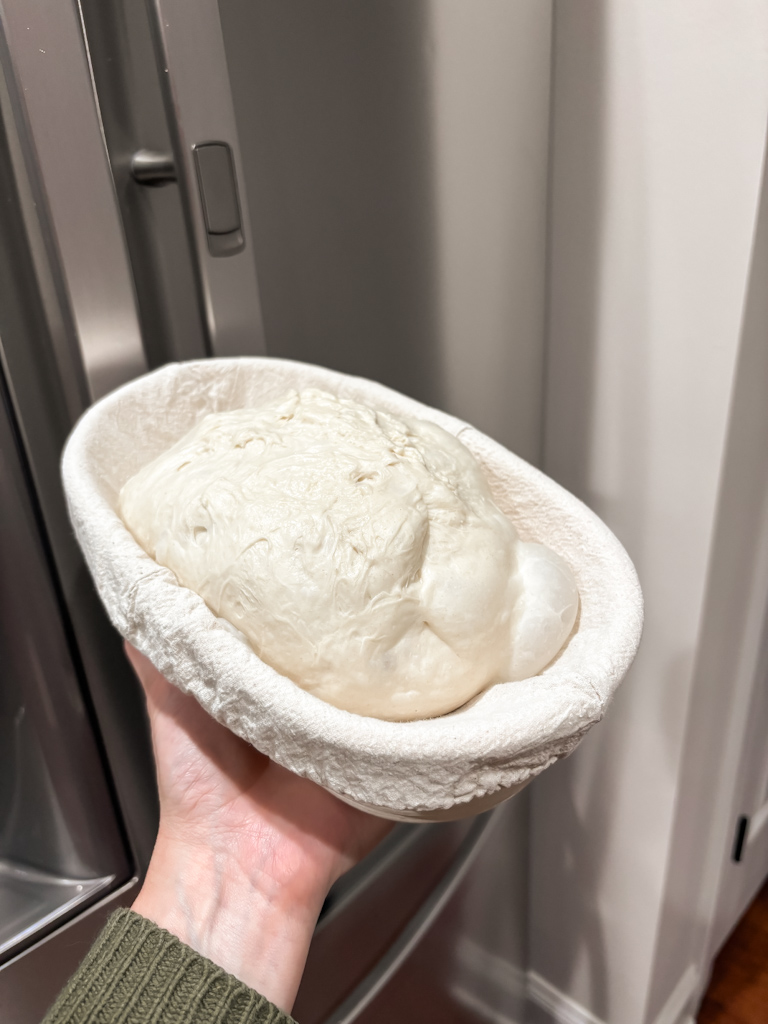
Cold Ferment Overnight
Cover with plastic wrap and refrigerate overnight or at least 12 hours OR up to three days! This is called cold-proof. The longer it sits, the better!
Score and Bake
The next day or whenever you’re ready to bake your loaves, place your dutch oven inside your oven and preheat to 500°.
Once your oven is ready, pull your loaf from the fridge and turn it over onto a large piece of parchment paper. Use your bread lame or a sharp knife or razor blade to score your design into the top of the dough.
Place your scored loaf along with the parchment paper into your hot dutch oven. Bake with the lid on for 25 minutes, and then lower your oven temperature to 450° and bake with the lid off for an additional 20-25 minutes.
Repeat the same for your second loaf. For best results, preheat the oven and dutch oven again to 500°.
Allow your loaves to cool on a cooling rack before slicing.
But if you can’t resist, try to at least wait 30 minutes.
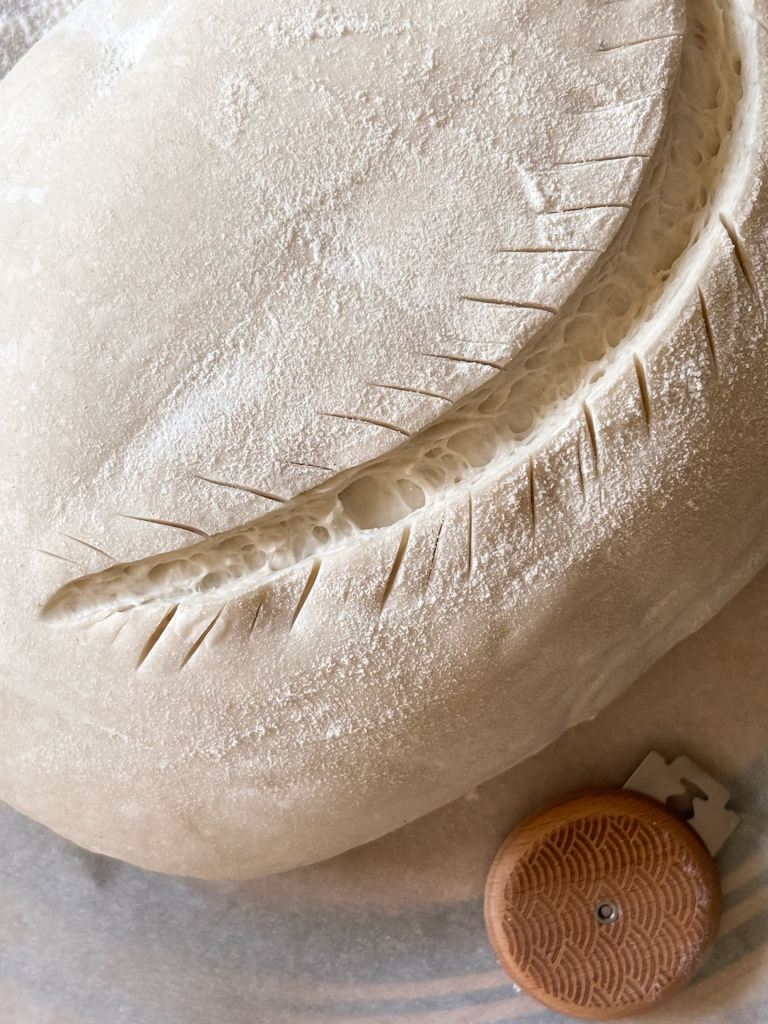
Bakers Timeline
Wake Up: Feed starter
4:00pm: Mix water and flour together to form a shaggy dough. Cover.
4:30pm: Add salt and incorporate. Cover.
4:45pm: Perform stretch and folds. There will be 6 sets. The first 3 are 15 minutes apart and the last 3 are every 30 minutes. This doesn’t need to be exact. Cover in between sets.
7:00pm: Stretch and folds are complete. Leave on the counter covered to bulk ferment.
9:00pm: Divide and shape loaves. Allow them to rest on the counter for 20 minutes.
9:20pm: Shape again and place in proofing baskets. Cover with plastic wrap and place in the fridge overnight.
The next morning or when time allows: Score and bake!
*Loaves can stay in the fridge for up to 3 days so that you can bake them when you have time. This is a great routine for anyone who works outside the home!
Be sure to grab the PDF download of my timeline BELOW!
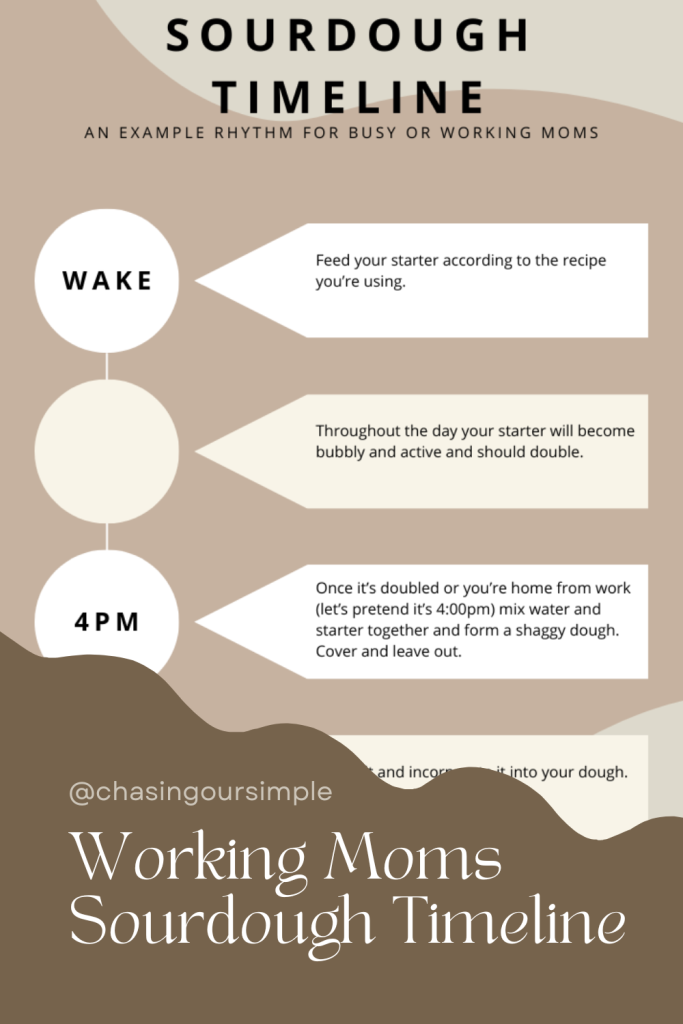
Baking Timeline for Overnight Sourdough Bread
One of the best parts about making this overnight sourdough bread recipe is that it’s made to fit with any schedule! Sourdough can be time-consuming and overwhelming but I hope to provide you with rhythms and routines that are doable and fit into your lifestyle!
This is the perfect recipe for moms who work outside the home. That’s why I’m offering a free download of my overnight sourdough recipe baking schedule. Just add your email below and the free printable PDF will go directly to your inbox.
More Overnight Recipes
Sourdough French Toast Casserole
Overnight Sourdough Pancakes
Sourdough Cinnamon Rolls

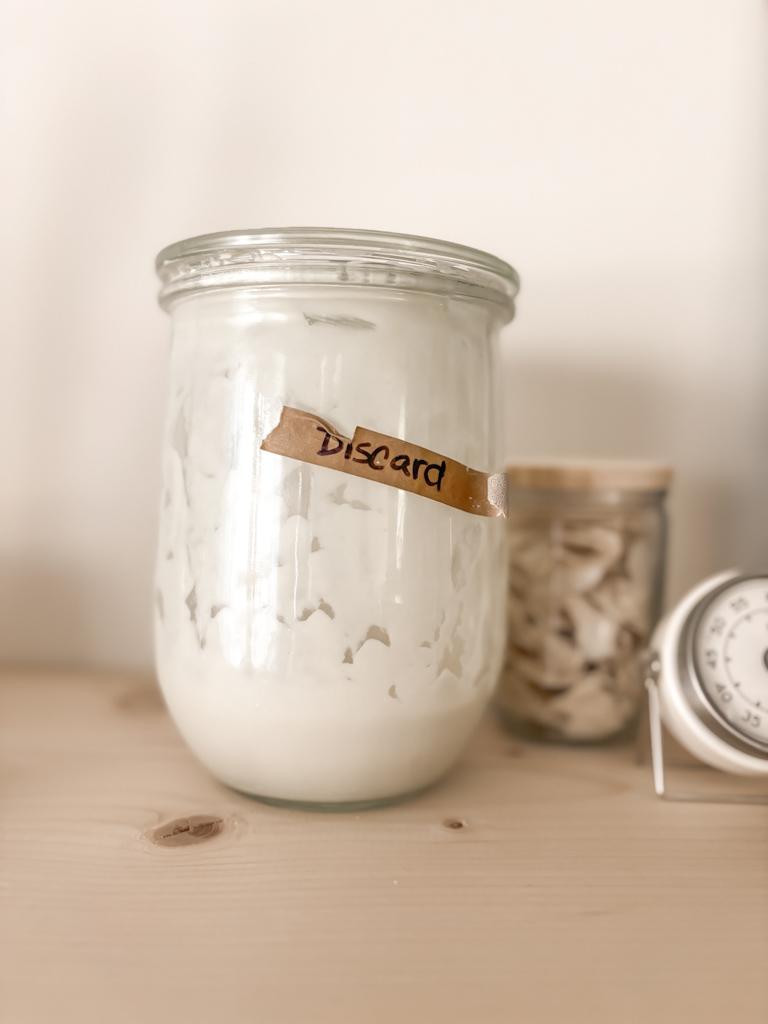

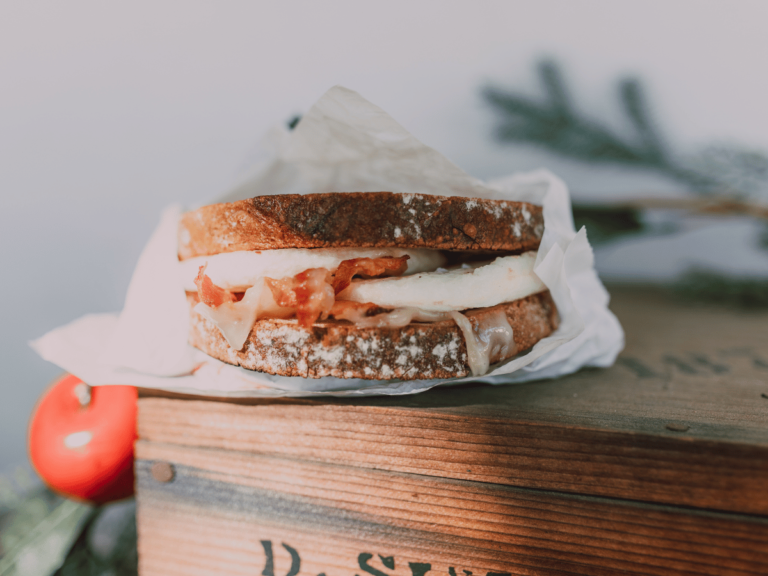
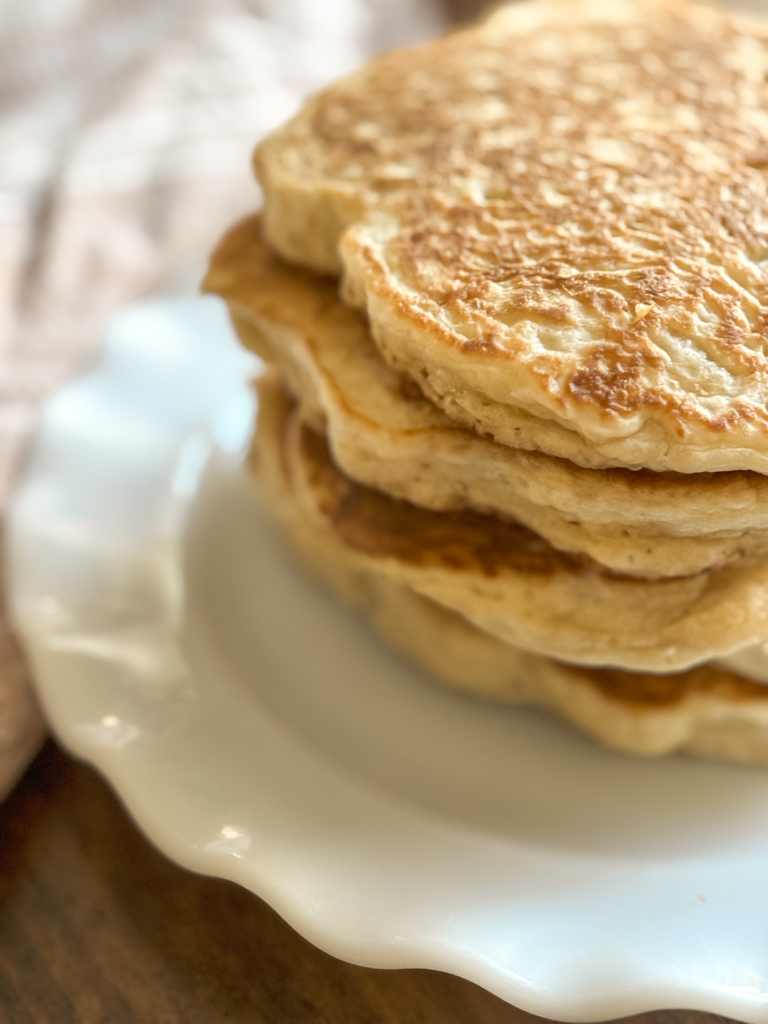


Thank you so much for putting this recipe in cups rather than grams, I don’t have a kitchen scale. My bread was delicious and came out perfect every time. This is now my go to recipe/site for sourdough. I also want to thank you for the leavin recipe, I was taking my entire starter out of the fridge every time I baked and discarding most of it for one or two loaves of bread. ( I’m obviously new to this 😉) you are so appreciated 🥰
Your faithful follower,
Kim
Thank you Kim! I’m so glad its been helpful 🙂
I’m still working out my starter and baking. Would I be able to half this recipe and have it still work out okay?
Thanks 😊
Yes, you could half the recipe but because it’s a smaller ammount you would need to be careful not to overproof. It’s really best in this case to stick to the recipe if you’re newer to sourdough.
Okay, thank you!